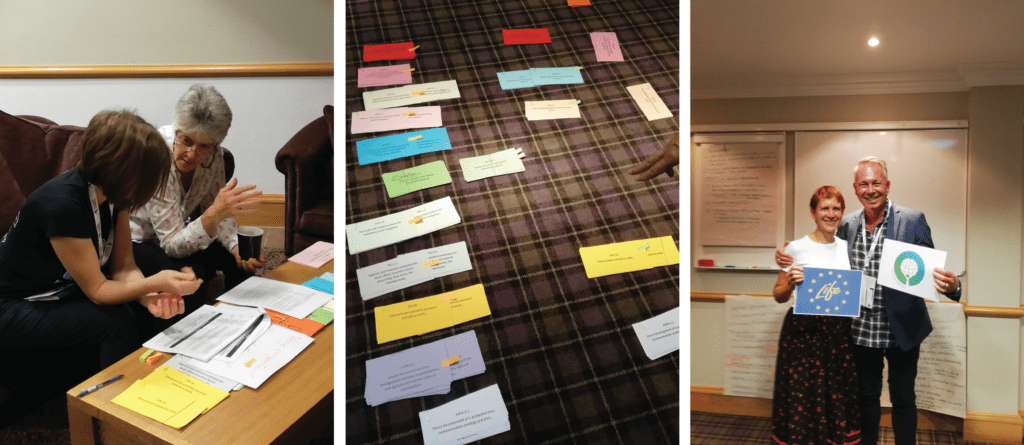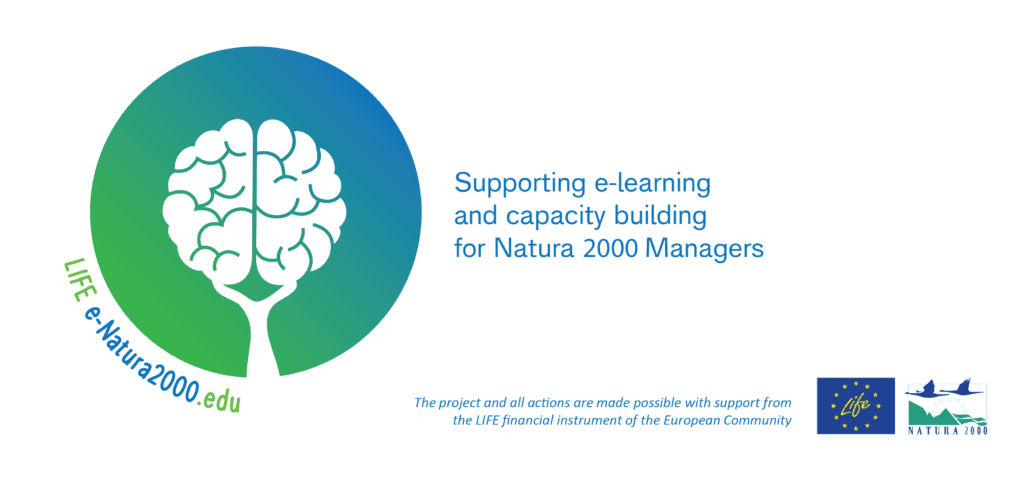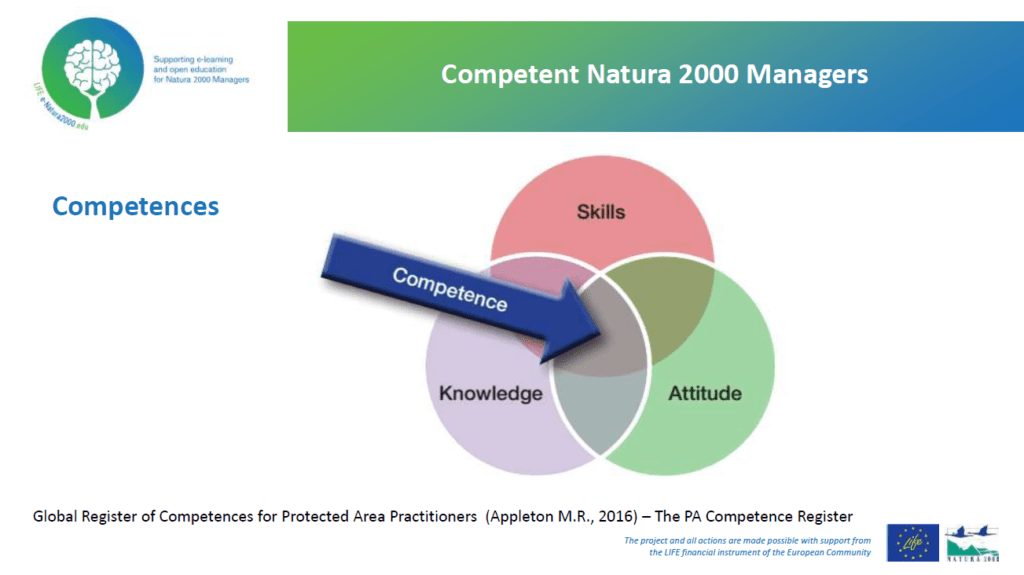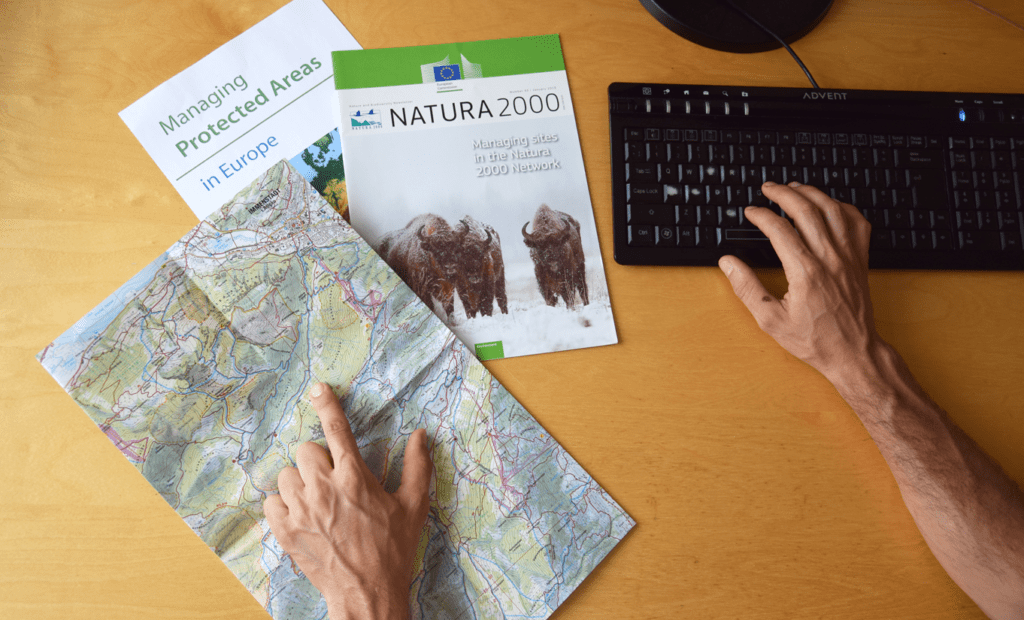The (needed) competencies for effective Natura 2000 Management
Covering over 18% of the EU’s land area and more than 7% of its marine territory, the Natura 2000 network is the largest coordinated network of protected areas in the world: the network includes the most valuable and threatened species and habitats of Europe. Although considerable progress has been made in the implementation of the measures legally required by the Nature Directives, ensuring effective management of individual Natura 2000 sites remains a challenge in most EU countries. In particular, deficiencies in practical implementation and inconsistencies of approach are widely recognised as adversely impacting on the practice and quality of Natura 2000 site management.
What are the core competence needs of Natura 2000 and Protected Area managers? How can we build practical capacities and know-how through innovative methods? Within the LIFE e-Natura2000.edu project, EUROPARC and its partners will deliver 3 blended-learning opportunities for Natura 2000 & Protected Area Managers in 2020. The first building block of the project has just been launched: an analysis of the competencies needed for the effective management of Natura 2000. The learning opportunities will open at the end of 2019… Stay tuned!
The challenge of effective Natura 2000 management
The outcome of the Fitness Check of the Birds and Habitats Directives made clear that they are ‘fit for purpose’ and demonstrate EU added value. The Directives have generated many important benefits for nature conservation and sustainable development overall. They provide a balanced and workable framework for addressing the varying interests of stakeholders while respecting nature conservation objectives. Overall the costs of implementation are reasonable and outweighed by the benefits, although they do impact some stakeholders more than others.
However, the evaluation also reveals problems with the pace and extent of progress that stem from implementation. While some problems have decreased over time as a result of experience, others require future action. From the perspective of improving Natura 2000 management in practice, implementation improvements are required in such areas as:
- management planning,
- provision of more and better information,
- increased guidance, more integration and joined-up delivery with other policies,
- increased awareness and involvement of stakeholders.
The evaluation study highlights that Natura 2000 sites do not exist in isolation: not only are they part of an ecological network which spans the EU, each site has different human and economic contexts which must be included in nature conservation decision-making. Therefore, not only do Natura 2000 managers need to know how to assess the condition of their site(s) and put in place the measures necessary to achieve conservation objectives, they also need to know their stakeholders and how to work with them to achieve those objectives.

Capacity Building workshop at EUROPARC Conference 2018, Scotland
There is a clear need to build capacity amongst Natura 2000 site managers in relation to, for example, the development of technical knowledge along with ways to ensure effective stakeholder engagement: the implementation of necessary site conservation measures, including the development and implementation of management plans, is after all fundamentally a participatory process which requires skilful working with nature and people at the same time.
How can we respond to that?
With the LIFE Preparatory project: ”Supporting e-learning and capacity building for Natura 2000 managers”, a three-year project that explores the potential of new approaches and methods to improve specific competencies and build practical capacity required by Natura 2000 site managers across the EU. The project aim is to strengthen the implementation of Natura 2000and contribute to the successful realisation of the EC’s Action Plan for People, Nature and the Economy.

This LIFE Preparatory project aims to contribute to closing the gaps between the ‘what’ and ‘how’ of Natura 2000 management. The project focuses on building practical capacities and know-how across a set of core competence areas identified as being fundamental to the work of Natura 2000 site managers from diverse backgrounds and operational contexts. The results from Action A1 form the ‘backbone’ of the project to be further developed across the other project actions.
1) Identification and assessment of competencies for management of Natura 2000
As part of Action A1, “Identification and assessment of competencies for management of Natura 2000”, a first technical meeting was held in Brussels. The project team and invited experts analysed the IUCN Global Register of Competencies for Protected Area Practitioners. The main objective was to identify a set of priority competencies specifically required by Natura 2000 site managers and for which the project will develop a set of innovative learning tools.
Download the Report: Identification and assessment of competencies for management of Natura 2000
This report summarizes the results of project Action A.1 and the contents represent the result of collective inputs from all project partners and external experts invited to the first technical workshop of the project. It provides:
1) an analysis of functions required to be performed by site managers for the efficient implementation of Natura 2000, based on the results of the Fitness Check of the Nature Directives (2016) and on the Nature Directives’ legal requirements;
2) a methodological framework for the development of a coherent, competence-based approach to capacity building for Natura 2000 site management;
3) a defined list of key competencies identified as being particularly relevant for Natura 2000 site managers across Europe – these lie in the fields of:
- Communication and collaboration, including the development of strong, inclusive participatory processes recognising the vital role of local communities and respect for cultures;
- Awareness and Education, including working with local communities and cultures;
- Natura 2000 policy, planning and projects focused on biodiversity conservation practices.

Summary of technical activities and functional areas of expertise required by Natura 2000 site managers
2) Understanding Natura 2000 implementation in different EU Member States
The Nature Directives require all Member States to provide the capacity necessary to secure a positive impact for Natura 2000 and establish a framework for effective implementation based on competent management practices. However, management of Natura 2000 sites is organised and approached differently by each Member State: in many countries, Natura 2000 sites are managed by governmental institutions acting at different levels of territorial responsibility; in other countries, management responsibilities for Natura 2000 are devolved or delegated to various entities. This diversity means that capacity needs to fulfill the specific management responsibilities for Natura 2000 are highly variable across the EU.
Below you can have an idea of how Natura 2000 is being managed in the countries of the project partners:
Natura 2000 Management in Austria
Natura 2000 Management in Croatia
Natura 2000 Management in Italy
Natura 2000 Management in the Netherlands
Natura 2000 Management in Romania
Natura 2000 Management in Spain
Natura 2000 Management in Sweden
3) Build a competence-based approach
In the IUCN ‘Global Register of Competencies for Protected Area Practitioners’, there are 15 competence categories, each of which covers specific skill and knowledge requirements to indicate what a Protected Area practitioner should know and be able to do.
Competence derives from the combination of knowledge, skills and attitude (K-S-A). A competent individual can clearly demonstrate that he/she has knowledge on the theoretical and technical aspects of a specific task, is able to perform that task reliably and consistently and complete it conscientiously. Competence-based approaches to capacity building are based around proven acquisition of the skills, knowledge and attitude needed for effective implementation of tasks and functions.

Competence is at the crossroads between Knowledge, Skills and Attitude.
Within the context of this LIFE Preparatory project, the competence-based approach to capacity building refers to providing learning opportunities that enable Natura 2000 site managers to develop or acquire the skills, knowledge and attitude needed to effectively perform tasks required of them by the Nature Directives. As for Protected Area practitioners, competencies (required or desired) by Natura 2000 site managers vary by staff levels and operating contexts. As explained in the report above, the competence needs are correlated with:
- the complexity of a given Natura 2000 site;
- its management objectives and implementation activities;
- the overall context, the type of management setting and governance arrangements;
- the specific responsibilities of involved organisations; and, available resources.
These are some of the multiple factors which need to be considered when identifying the competencies required by individual Natura 2000 site managers and when designing approaches to capacity building.
4) Building Capacity
The project Partners will deliver 3 core competence Modules in 2020, which will focus on:
- Biodiversity conservation: policy, planning & projects for Natura 2000 (led by ProPark) ;
- Effective communication & collaboration for Natura 2000: engaging local communities & working with cultures (Led by FUNGOBE);
- Powerful communication for Natura 2000 managers (Led by EUROPARC)
Within the project, there will 3 blended-learning opportunities for Natura 2000 & Protected Area Managers. Registrations will open at the end of 2019.
Natura 2000 and Protected Areas
The relationship between Natura 2000 sites and Protected Areas varies across different Member States: in many countries, Protected Areas were formally established years before Natura 2000 sites were designated. Unlike Natura 2000 sites, Protected Areas are not designated legally by the EU: various country-specific, national or regional, legal protection mechanisms are applied for Protected Areas.
In some cases, Natura 2000 sites may lie within a Protected Area, but not always, and there may be different management arrangements and requirements. Probably reflecting the fact that Protected Areas generally precede Natura 2000 sites, dedicated teams are not always in place for Natura 2000 site management.
However, although the legal status of Natura 2000 sites is different to Protected Areas, there is clearly a significant overlap in terms of the primary responsibilities and functions of Natura 2000 site managers and Protected Area practitioners. Often, the same people are involved working for the conservation needs of a Natura 2000 site and a Protected Area: even when different people are involved, the same nature conservation practices, skills, knowledge and expertise are required.

The report has been produced by Propark Foundation for Protected Areas, project partner responsible for project implementation Action, ‘A.1’, in collaboration with the EUROPARC Federation. This report is a project deliverable of the LIFE Preparatory project LIFE e-Natura 2000.edu (LIFE17PREDE003). The project is funded by LIFE financial instrument of the European Community and implemented by EUROPARC Federation with support of five partners: ProPark, Fungobe/ EUROPARC Spain, TESAF University of Padova, European Landowners Organisation, and the Kullaberg Nature Reserve.